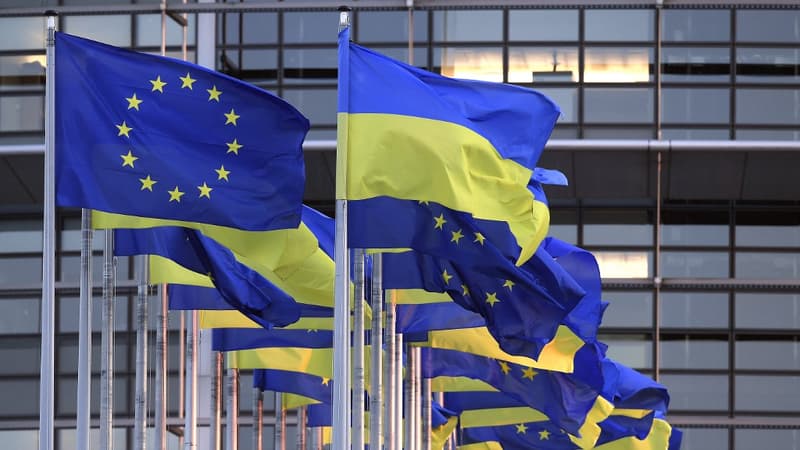To help Ukraine, Europe is doing everything it can, but is it enough? EU political, military and defense industry leaders met in Brussels on Thursday to address this crucial issue at the annual conference of the European Defense Agency (EDA). And the observation is clear: it is still insufficient. Faced with the war economy launched in Russia, shipments to Ukraine are not keeping pace, laments kyiv, which fears a brutal offensive this winter with energy infrastructures as the main objectives.
For a year now, arms shipments from Europe have been weakening and the desire for support is no longer unanimous. In 2022, the 27 EU countries increased their military spending on average by 6%, up to €240 billion, to rearm and support Kiev. These budgets represented on average 1.5% of the EU’s GDP when the objective required by NATO is at least 2%.
In detail, only six countries increased their budget by more than 10%. Before ratifying its NATO membership, Sweden achieved a record 30% increase. For France, during the last year of application of the Military Programming Law 2019-2022, the increase was only 0.7%.
Russia in the war economy
On the other hand, Russia has tripled its defense budget in just one year. Its military budget is already at 30% of its GDP and in 2024 it will increase another 67%. Moscow has even decided to allocate 200 million euros of defense R&D to produce more tanks and ammunition, says the European Defense Agency (EDA). According to kyiv, the Russians fire around 60,000 projectiles every day.
In addition, Russia benefits from increasing aid from its Iranian and North Korean allies. In September, Pyongyang provided “more than a thousand containers” of weapons and ammunition, according to Washington, which fears that in return Moscow will help this ally modernize its armies with combat aircraft and air defense batteries.
With Iran, trade could be even more important. Tehran recently confirmed an agreement to obtain from Moscow the means to modernize its air forces with Sukhoi Su-35 Flanker-Es, Mil Mi-28 attack helicopters and Yak-130 training aircraft. The counterpart would be the kamikaze drones (Shahed and Mohajer) used for deep offensives. A few days ago, the Russian army launched an offensive on kyiv with 75 Shahed drones in successive waves. The Ukrainian army managed to intercept them at the cost of a drastic weakening of its ammunition reserves.
According to Volodymir Zelensky, Moscow has already ordered 2,000 drones from Iran. But, above all, an agreement between both countries aims to create a drone factory in Russia that should enter production at the beginning of 2024.
Consistency and visibility
Faced with this power, the European Union is doing what it can. It has already supplied 300,000 artillery ammunition using its reserves. The EU continues to reaffirm its support, but some countries, notably Hungary, are reluctant to pay more. On Thursday, European Council President Charles Michel proposed using European loans dedicated to defense.
Another problem is the consistency of the weapons shipped, which are not always compatible with each other. At the EDA meeting, European Commission President Ursula von der Leyen harshly criticized this cacophony. Ukrainian forces use “more than 200 different weapons systems,” Ukraine’s ambassador to NATO, Nataliia Galibarenko, recently reported.
For their part, arms manufacturers agree to produce more, but demand visibility, consistency and contracts. The EU has established a joint contract financing mechanism to meet Ukrainian demand, but things are not moving fast enough.
The EU has promised to supply one million artillery shells to the Ukrainian army by March, but German Defense Minister Boris Pistorius admits this target will not be met. Ukraine “consumes” around 10,000 drones a month, recalled Ursula von der Leyen, and more than 400,000 mortar shells during the same period, stated the Ukrainian Deputy Minister of Defense, General Ivan Havryliuk.
Putin’s dream is the nightmare of Ukrainians
To address this situation, Ukraine will dedicate 50% of its spending to defense and security in 2024, or 22.1% of GDP. “All our internal resources will be used to resist and defeat the enemy,” said Prime Minister Denis Chmygal.
To ensure that neither Putin’s dream nor the Ukrainians’ nightmare come true, the United States and the European Union have made announcements in recent days. The US Secretary of Defense, Lloyd Austin, traveled to kyiv to announce new aid of 100 million dollars that includes, among other things, anti-aircraft defense means. Added to this amount is an endowment of 1.3 billion dollars from Germany.
Independent initiatives appear. A Czech businessman has launched a crowdfunding operation under the name “Gift for Putin.” This prize fund has already raised $27.5 million (€23.1 million) from more than 188,000 donors, for the purchase of a tank, a rocket launcher, a mine clearance system, drones and ammunition. The project now aims to purchase a Black Hawk helicopter for $4 million. A drop in the ocean that is still worth taking advantage of for a country at war since February 24, 2022 against one of the greatest military powers on the planet.
Source: BFM TV


